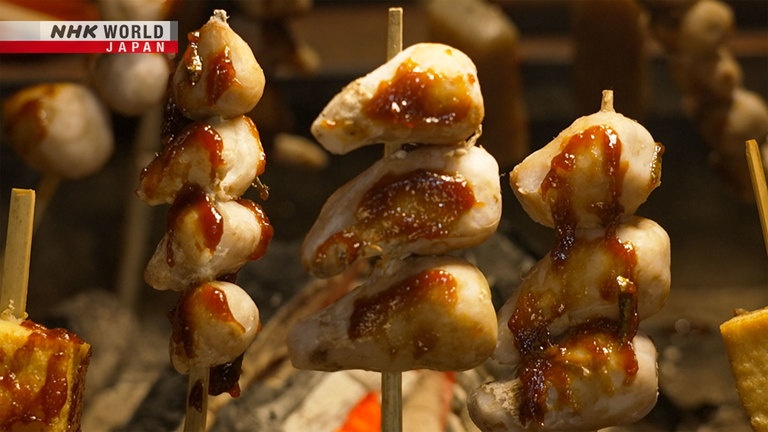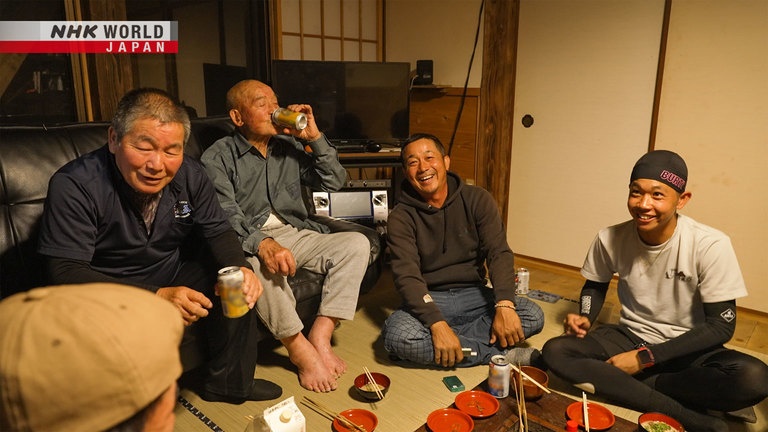A Craftsman's Roots
Honda Sueyasu has spent a lifetime thatching roofs and making sure a delicious taro thrives in his community. The eternally jovial 96-year-old is now passing on those passions to the next generation.



Transcript
Time-honored crafts are always worth preserving.
It's done!
And so are the flavors we've loved since childhood.
There's no better feast.
From one generation to another.
I can't let this tradition die with me.
Let's follow this man's story by looking through the kitchen window.
The town of Takamori in Kumamoto Prefecture sits in the caldera of Mt. Aso.
The area is famous for the production of pampas grass.
And 96-year-old master craftsman Honda Sueyasu has been harnessing this plant for years.
These are good.
He makes thatched roofs in a style dating back to ancient Japan.
The pampas grass is dried, cut, and laid out.
It keeps buildings cool in summer and warm in winter.
Creating the angles and curves needs a great deal of skill.
Sueyasu displayed a talent for the work in his 20s.
And the rest is history.
Now, he's passing those skills on to his son and grandson.
We store the pampas grass here.
Grandson Tatsuo is in charge these days.
My grandfather no longer works on-site.
But he cuts about 1,000 bundles of
pampas grass every year, all on his own.
He's probably the only person his age
still cutting grass.
We need to keep refining our skills.
Eighty years ago, most houses here had thatched roofs.
Many of those still standing are considered pieces of cultural heritage.
The number of thatchers has also dwindled.
What's important is whether future
generations continue this work.
But that's not the only thing Sueyasu wants to pass on.
He can often be seen toiling away in his garden.
He carefully tends to the things he grows.
And there's one vegetable he loves most of all.
Isn't this a great taro?
I'd give it full marks.
This is Tsurunoko taro, a local specialty.
The soil here is volcanic.
It's not as nutritious as soil elsewhere.
Tsurunoko is an uncommon taro.
But it grows well here because of the unique soil.
Some say they look like the necks of cranes.
In Japanese - "tsuru."
I need to ensure the taro
here grow big and strong.
Just like the people.
Sueyasu's family love Tsurunoko because they make for a delicious snack.
Especially when freshly harvested.
We let him take charge.
He loves his taro.
I'm home!
The family gravitate toward the steaming pot.
Boiling takes about 50 minutes.
OK. Done!
Sueyasu recommends enjoying them simply with soy sauce.
Good!
My taro farming skills make
all the difference.
Sueyasu and his wife also earn a living by farming.
And Tsurunoko have played a starring role.
Everyone used to have a vegetable garden.
We all planted taro.
I've been eating them
since I was a child.
It's nothing new.
But during and after World War Two, Tsurunoko fell out of favor.
They are such a small taro.
They become even smaller when peeled.
That doesn't leave much to eat.
People said Tsurunoko are no good,
and they started to fade away.
But Sueyasu and his wife didn't give up on this humble little vegetable.
They joined hands with the other townsfolk to start a revival, and offered Tsurunoko at events.
They served them with a sweet miso sauce.
The dish is called "Takamori Dengaku."
It's been an absolute favorite of Sueyasu's since he was a boy.
Word soon spread.
And in turn, more farmers started planting Tsurunoko.
Let me show you how it's done!
Sueyasu doesn't want a lifetime's work to go to waste.
So he's passing the baton to his family.
- It'll become extinct if we stop.
- This taro is like no other.
I've tried growing Tsurunoko before,
but it didn't go very well.
They weren't like Grandpa's.
I realized they need a lot of care.
I've been teaching what I know
ever since I was young.
We need to give all this
to our successors.
I can't let this tradition die with me.
Times are changing on the rooftops, too.
Three years ago, Sueyasu's great-grandson Ryuki started on the path to becoming a thatcher.
Few people choose this profession,
but I think my dad's work is cool.
I've been wanting to do this
ever since I was a boy.
Ryuki is the youngest thatcher in Japan.
Just 19 years old.
Before long, he'll become the torch bearer.
Our fourth generation also has
great talent.
I dream of him becoming a master.
Someone who will make his name
known among future generations.
The family are hosting a dinner party for their fellow thatchers.
And there's no guessing what's on the menu.
Misako is preparing the Dengaku sauce.
It's made with sake and a blend of four sugars.
I also add Japanese "sansho" pepper leaves.
This is my own recipe.
I adjust the sweetness to my liking.
Sueyasu loves it.
Thank you for the preparations.
This is my special taro.
Sueyasu's family and the other thatchers have all come together.
You need to stick it in diagonally.
Sueyasu even makes the skewers by hand.
The meal includes Tsurunoko, "konnyaku" and tofu - all grilled by the flaming charcoals of the hearth.
And of course, everything's slathered with plenty of sauce.
We used to have a hearth in the
house when we were children.
I enjoyed sitting there,
making "Takamori Dengaku."
Nothing better than this.
I can taste the "sansho!"
The miso is delicious!
Who made it?
Me, of course!
I'm so happy.
Maybe too happy.
Four generations, right here.
Sueyasu loves bringing people together.
He does that by putting roofs over their heads and keeping them well fed.
Grandpa, you're crying!